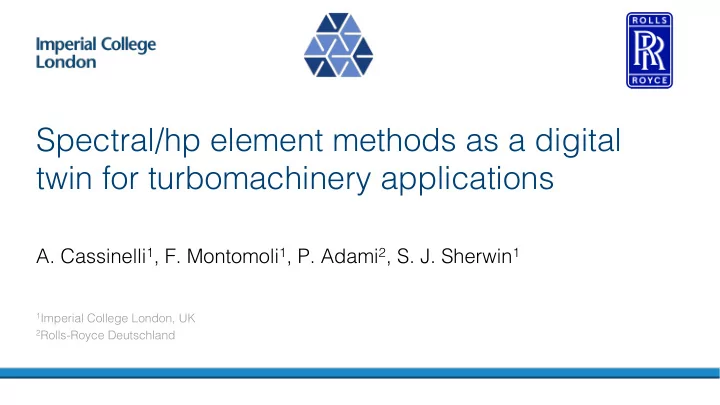

Spectral/hp element methods as a digital twin for turbomachinery applications A. Cassinelli 1 , F. Montomoli 1 , P. Adami 2 , S. J. Sherwin 1 1 Imperial College London, UK 2 Rolls-Royce Deutschland
Outline Nektar++ Workshop 2019 • Motivation. • Computational approach. • Test case 1: resolution study of T106A with clean inflow at Re = 88450. – Effect of increasing polynomial order. • Test case 2: representative industrial LPT with inflow disturbances at Re = 111200. – Momentum forcing near the leading edge. – Random Fourier method for synthetic turbulence generation at the inlet. • Conclusions. 2/16
Motivation Nektar++ Workshop 2019 1. Advanced scale resolving DNS and LES CFD simulations as a feasible aero-thermal performance prediction tool. 2. Fast-paced technological progress in High Performance Computing. 3. The Nektar++ software framework platform fulfils the key requirements. Rolls-Royce Trent 1000 3/16
Test case and computational approach Nektar++ Workshop 2019 Computational base mesh of the T106A blade and (zoomed) Near wall mesh resolution with ! = 7 , $ % = 0.2 , ) % = 96 . high-order LE and TE mesh with ! = 7 . 4/16
P-refinement on blade statistics Nektar++ Workshop 2019 Left: time- and spanwise- averaged pressure distribution. Right: Evolution of momentum thickness ( θ ) and shape factor (H) along the suction surface (740 stations). PROPERTY P=3 P=5 P=7 C P 0.0367 0.00262 0.000939 C F 0.196 0.00797 0.00221 Table on the left: RMS of the relative error with respect to case P=9. (S/S 0 ) SEP 0.0221 0.00400 0.000512 Θ 0.216 0.0131 0.00361 H 0.153 0.0118 0.00305 5/16
P-refinement on velocity spectra Nektar++ Workshop 2019 PSD of streamwise velocity in the turbulent wake. Skin friction coefficient map 6/16
However… Nektar++ Workshop 2019 • The cascade with clean inflow behaves like an extremely silent wind tunnel. • The presence of low levels of physical noise is necessary to trigger a more realistic transition and reattachment mechanism. • Two approaches are investigated: – Momentum forcing near the leading edge – Random Fourier method for synthetic turbulence generation at the inlet 7/16
Momentum forcing near the LE Nektar++ Workshop 2019 − [ ( x − xc )2+( y − yc )2 ] g ( z ) I ( t ) · g ( z ) 2 · α · e δ 2 R Lz √ N body 0 ✓ 2 π ◆ − [ ( x − xc )2+( y − yc )2 ] f u ( x, y, z, t ) = X g ( z ) = A i sin iz + φ i g ( z ) I ( t ) · g ( z ) 2 · β · e δ 2 L z R Lz √ i =1 0 0 8/16
Time-varying bodyforcing Nektar++ Workshop 2019 9/16
Synthetic inflow turbulence Nektar++ Workshop 2019 E ( κ ) = α u 2 ( κ / κ e ) 4 [1 + ( κ / κ e ) 2 ] 17 / 6 e [ − 2( κ / κ η ) 2 ] rms κ e u n = � 1 / 2 E ( | κ n � ˆ j | ) ∆ κ N turb u n cos( κ n X j x j + ψ n ) σ n u 0 i ( x j ) = 2 ˆ i n =1 q e − ∆ t/ T � 2 a = e − ∆ t/ T � b = 1 − i,in ) t = a ( u 0 i,in ) t � ∆ t + bu 0 ( u 0 i L. Davidson. Using isotropic synthetic fluctuations as inlet boundary conditions for unsteady simulations. Advances and Applications in Fluid Mechanics 1.1 (2007), pp. 1-35. 10/16
Turbulence intensity evolution Nektar++ Workshop 2019 TKE evolution in the development region of the domain. Streamwise velocity spectrum in various stations 11/16
Pressure distributions Nektar++ Workshop 2019 Pressure coefficient with increasing bodyforcing intensity (left), and comparison with experimental data and inflow turbulence approach (right). 12/16
Skin friction coefficient Nektar++ Workshop 2019 Skin friction coefficient with increasing bodyforcing intensity (left) and synthetic inflow turbulence (right). 13/16
Boundary layer parameters Nektar++ Workshop 2019 Boundary layer parameters with increasing bodyforcing intensity (left) and synthetic inflow turbulence (right). 14/16
Wake profiles Nektar++ Workshop 2019 Comparison agains experimental data: velocity wake (left), turbulent kinetic energy (middle) and KSI (right). 15/16
Conclusions Nektar++ Workshop 2019 • Towards Digital Twin/ Virtual Wind Tunnel à High Order Methods. This work shows how to tackle the problem. • P-refinement is demonstrated to be a powerful tool to achieve results convergence on a range of statistics. • Comparison between inflow disturbance mechanisms: – Momentum forcing: more “artificial” and cheaper method, proven useful investigation tool – Synthetic inflow turbulence: more robust and expensive method. 16/16
Nektar++ Workshop 2019 Thank you for your attention Cassinelli A., Montomoli M., Adami P., Sherwin S. J., 2018. "High fidelity spectral/ hp element methods for turbomachinery". ASME Paper No. GT2018-75733. Cassinelli A., Xu H., Montomoli M., Adami P., Diaz R. V., Sherwin S. J., 2018. ”On the Effect of Inflow Disturbances on the Flow Past a Linear LPT Vane Using Spectral/ hp Element Methods". ASME Paper No. GT2019-91622. The authors gratefully acknowledge Rolls-Royce plc. for permission to publish this work, which was supported by the ARCHER UK National Supercomputing Centre under grants No. EP/L000261/1 and No. EP/R029326/1, as well as Imperial College RCS (DOI: 10.14469/hpc/2232) .
Recommend
More recommend